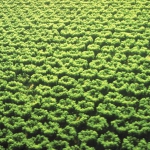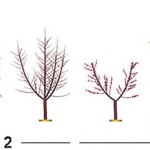When you eat a fresh peach, chances are 50-50 that it came from California. If it’s a processed peach, chances are virtually certain, at 97 percent. While Georgia and South Carolina contend for the title of Peach State in the eastern United States, 75 percent of all peaches grown in the United States come from California.
In that state for nearly four decades, how farmers grow peaches has been highly influenced by a team of University of California peach specialists—-especially Ted DeJong, R. Scott Johnson, and Kevin Day.
It was Dr. DeJong who, speaking this spring at the Cornell University In-Depth Fruit School, inspired the title of this series of articles. He spoke about the changes that have occurred during his 33-year career.
During that time, the art of growing peaches has been changed to a science by the research discoveries of tree fruit physiologists.
What growers do in shaping young trees, how they prune trees as they mature, and when and how they thin the blossoms and green fruit is now dictated by scientific principles discovered by physiologists, many of them still working but coming toward the end of their careers.
DeJong’s early work focused on understanding how tree leaves function.
“As I gained experience and understanding of factors controlling the ‘supply side’ of the carbon balance equation, I later focused on the ‘demand side’ of the equation and their integration into a functional understanding of how tree carbon budgets work,” he said.
This required understanding how flowering and fruit set work, how fruit, shoots, leaves, and roots grow, and how rootstocks control shoot growth.
“This led to the development of very sophisticated and complex -functional-structural tree simulation models that are not only carbon budget models but also include integrated understanding of -architectural development of fruit trees,” he said.
There are three kinds of shoots on a peach tree, DeJong explained during the Cornell fruit school, and each responds differently to pruning. In what seems counterintuitive, “You cut what you want to grow,” he said. But the cut will result in one of three responses, depending on the kind of wood that is cut.
Three kinds of shoots
Proleptic shoots bear the crop, and they grow from terminal or lateral buds after dormancy is broken. -Syleptic shoots are lateral shoots that grow immediately off the main axis of a vigorous shoot without first forming a -dormant bud.
Epicormic shoots (growers often call these water sprouts) grow where two-year-old (or older) limbs have been pruned or broken, and grow rapidly as long as growing conditions are favorable.
Proleptic shoot buds are often entirely preformed (all parts were already present in the dormant bud). Syleptic and epicormic buds do not develop from dormant buds.
Proleptic peach shoots rarely form more than 34 nodes in a season, and since new nodes appear every two to three days, all proleptic shoot growth occurs within 90 days of bud break (by mid-June in California). Syleptic and epicormic shoot growth can occur throughout the summer.
Shoot structures display relatively consistent distributions of blind nodes and nodes with different combinations of lateral vegetative and flower buds along their axes. Proleptic shoots tend to have greater proportions of nodes with flower buds than syleptic or epicormic shoots.
Another factor that tends to strongly affect tree
architecture is apical dominance.
As a basic rule, apical dominance tends to depress the growth of shoots below the tip. Thus, if a shoot is not pruned, all new shoots will be shorter than the parent, while cut shoots will be invigorated and grow longer.
Shaping a tree
The way California growers train peach trees is by taking a tall whip from the nursery and cutting it off at about 20 inches, removing all side branches. The tree’s response is to grow many “epicormic shoots”—water sprouts.
From these, growers will select, during the dormant period, anywhere from two to six shoots, depending on the style of tree they want to grow. It can be upright like a -Perpendicular V, Quad V, Hex V—trees conforming to a “V” shape with two, four, or six main scaffolds —or a more circular open–center vase style.
These selected shoots become the basis for scaffolds. During dormancy, they will be headed hard again to -continue scaffold development or to develop multiple secondary scaffolds.
“In the first year, we want water sprouts to form -scaffolds,” DeJong said. But after the tree is formed, water sprouts are undesirable, “the bane of a grower’s -existence,” and result in excessive vegetative growth, he said.
To prevent water sprouts, growers shift to avoiding heading cuts and doing renewal pruning to stimulate new fruiting shoots and keep enough fruit wood for the next year’s crop but avoid heading cuts into older branches.
In pruning, DeJong said, growers work with “reiteration,” the tendency of a tree to replace any vegetative part with a new part like the one that was broken or pruned away. “The strength of the reiteration after pruning depends on the type of pruning cut, the amount of growth that was lost, and the timing of the pruning.
The growth of epicormic shoots (water sprouts) from preventitious buds is the tree’s natural way to rapidly replace large parts of the canopy that is lost.”
In California, the long growing season generates -vigorous growth that growers must battle to keep tree height under control. They use mechanical toppers because they are inexpensive, but this results in more upright water sprout growth.
“Recent research combining our new size-controlling rootstocks, the Controller series, with Quad and Hex V systems has resulted in very productive pedestrian orchards with tree heights less than eight feet tall so all hand work can be done from the ground,” he said.
Peach growers would love to have the choices of -rootstocks apple growers enjoy, he said.
Managing fruit load
“Fruit growth and yield are dependent on two separate but interdependent sets of processes,” DeJong said.
Developmental processes vary by cultivar and govern fruit growth potential during any period of time, he said. For the first month after bloom, fruit development (that drives growth potential) is strongly influenced by heat accumulation.
Higher temperatures within one month after bloom increase the rate of fruit development.
Fruit growth potential is determined by genetics, he said. Fruit growth at any given time can be compared to the growth of money invested at compound interest. “Fruit growth potential that is lost early in the season cannot be made up later,” he said. “To optimize fruit size and yield, crop load adjustments need to be made as early as economically feasible, especially in years of heavy fruit set.”
Interest in blossom thinning is increasing not only because it reduces labor costs, but also because it avoids setting fruit that will be lost in the fruit thinning process.
“Thin the tree early enough so that the tree can supply enough resources to remaining fruit to pay their potential interest rate. Optimal timing and amount of thinning can increase both fruit size and yield.”
Temperature accumulations in the first month after bloom have a very large effect on fruit development.
In California, the growing degree-hour accumulation during this period can vary by 100 percent (from 4500 to 9000 growing degree-hours), and this can cause the time for fruit development (time from bloom to fruit maturity) to vary from year to year by as much as 30 days for a given cultivar.
Warm springs speed up fruit development, which increases demand on the tree’s resources. Thus, counterintuitively, warm springs lead to a tendency for fruit to be smaller because it is more difficult for the tree to keep pace with potential fruit growth demands.
“This is also a likely explanation for why large fruit sizes in some warm locations are hard to achieve,” he said.
For more information on DeJong’s research, go to http://ucanr.edu/sites/fruitreport/.
____

Ted DeJong
Peaches and prunes are his forte
Dr. Theodore M. DeJong (pronounced “DeYoung”) joined the faculty at the University of California, Davis, in 1981 after earning his doctorate there in 1977.
Much of his intellectual stimulation for tree fruit physiology research came from his goal of developing integrated understanding of fruit tree carbon budgets and growth through crop modeling.
In addition to his work with peaches, he has been the principal investigator on a prune-breeding project since 1985.
The goal is to develop new prune (dried plum) cultivars that will increase orchard efficiency, spread the harvest season, and maintain or increase dried product quality.
The industry currently depends on one cultivar, French, but new cultivars seeking a place include Muir Beauty and Tulare Giant, which are earlier, and Sutter, which is later. California produces 99 percent of prunes grown in the United States.
Last year, DeJong received the title of Distinguished Professor at UC Davis. This year, he received the
Outstanding Research Career Award from the Environmental Physiology of Fruit Crops Working Group of the International Society of Horticultural Sciences.
-—R. Lehnert








Have you ever heard of people planting concrete slabs under the soil on the south side of peach trees? I have to assume that it was done to accumulate heat.
The tree itself is an erratic producer, one year loaded with fruit and the next sparse. Delicious fruit whether the crop is full or sparse. Made the mistake of watering one year and literally destroyed the fruit.
Thanks for providing several novel infinformats and saturating with countless tips for many farmers like me
In today’s internet, it is refreshing to read such an article based on science and facts, condensing decades of hard work, and yet sharing the know-hows so generously and kindly. Thank you! It is nice to read the user comments here as well. Not a lot, but each very grounded. I can only guess that planting trees and growing one’s own food changes one to a more wholesome person.